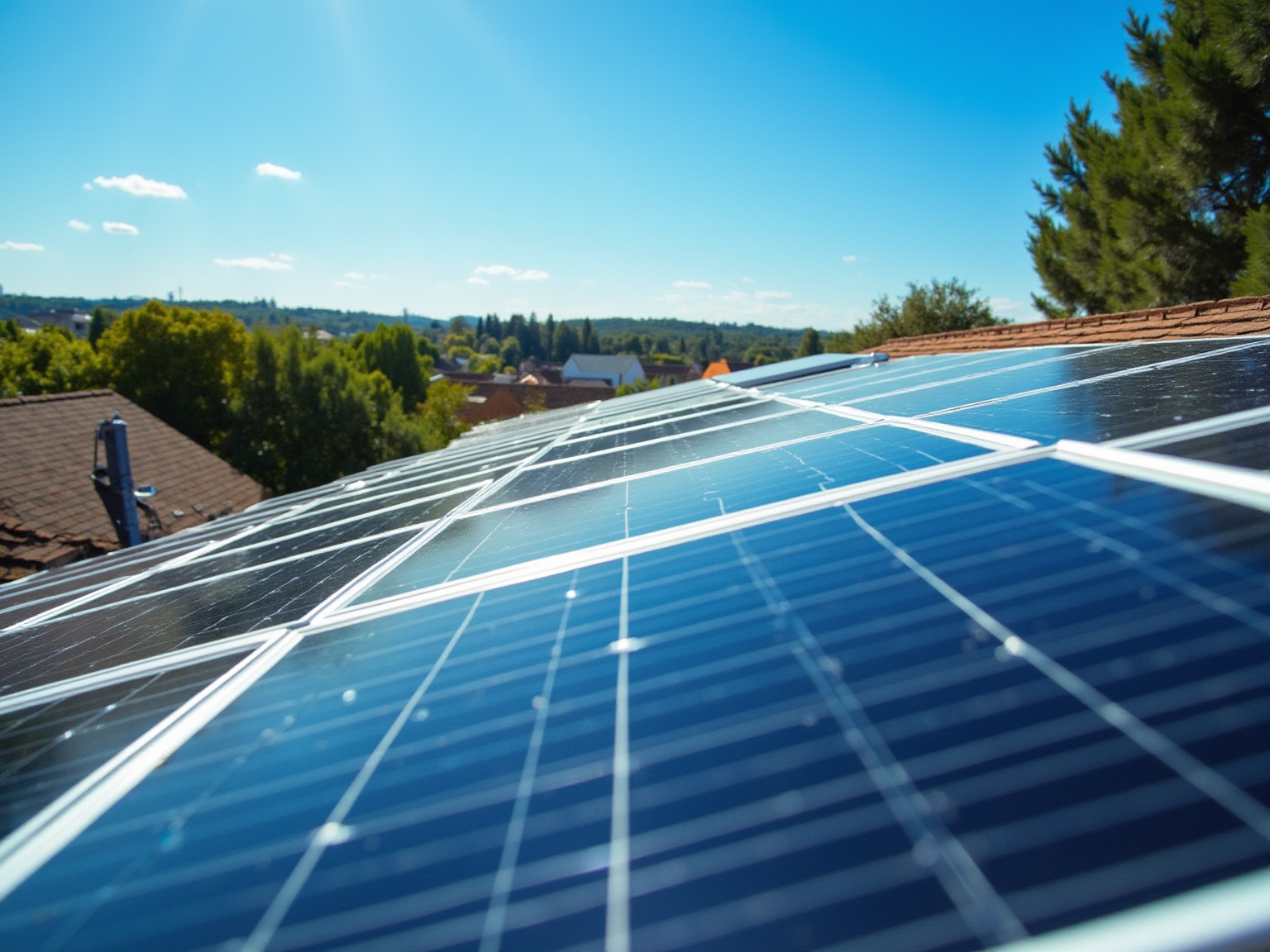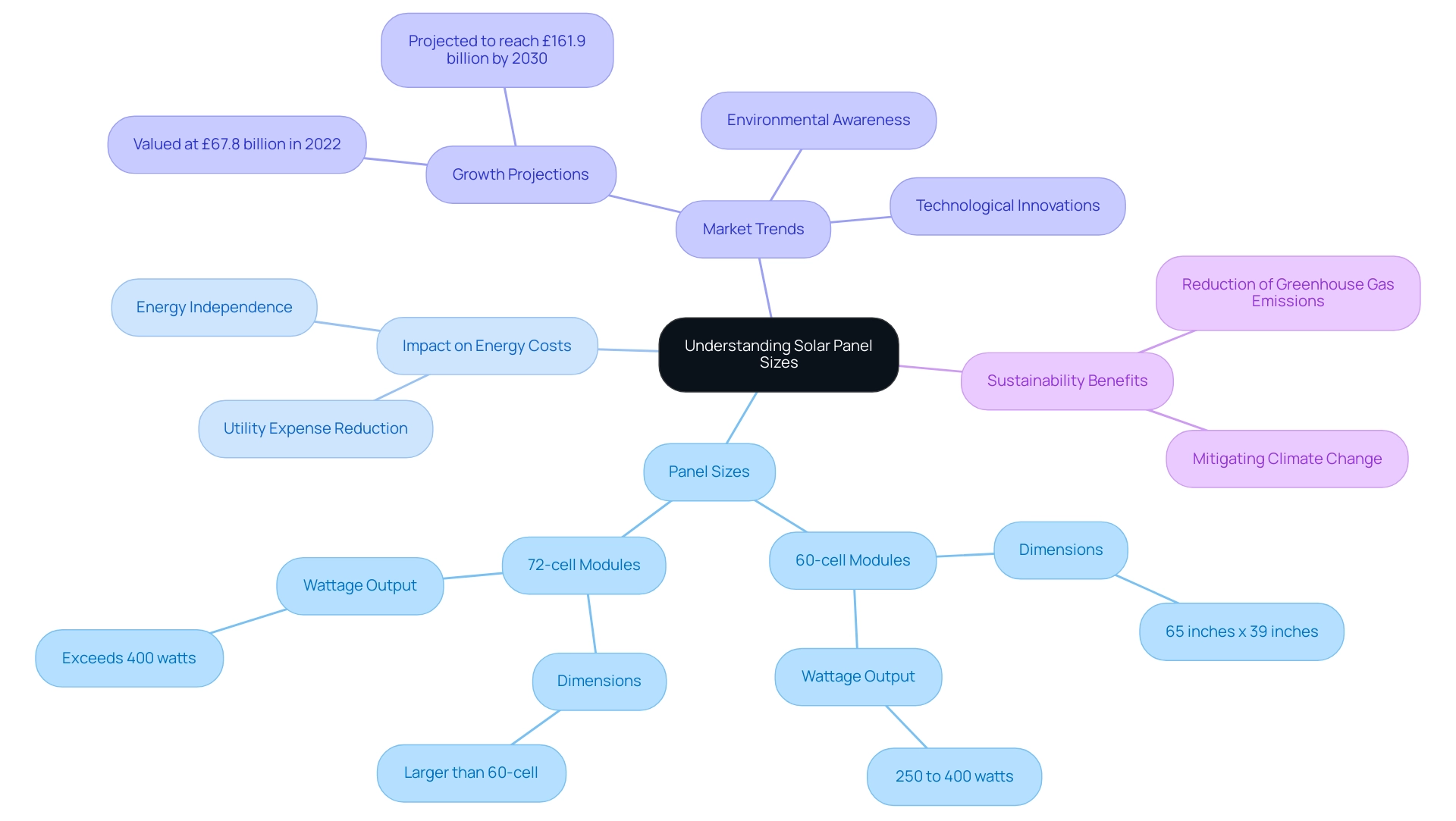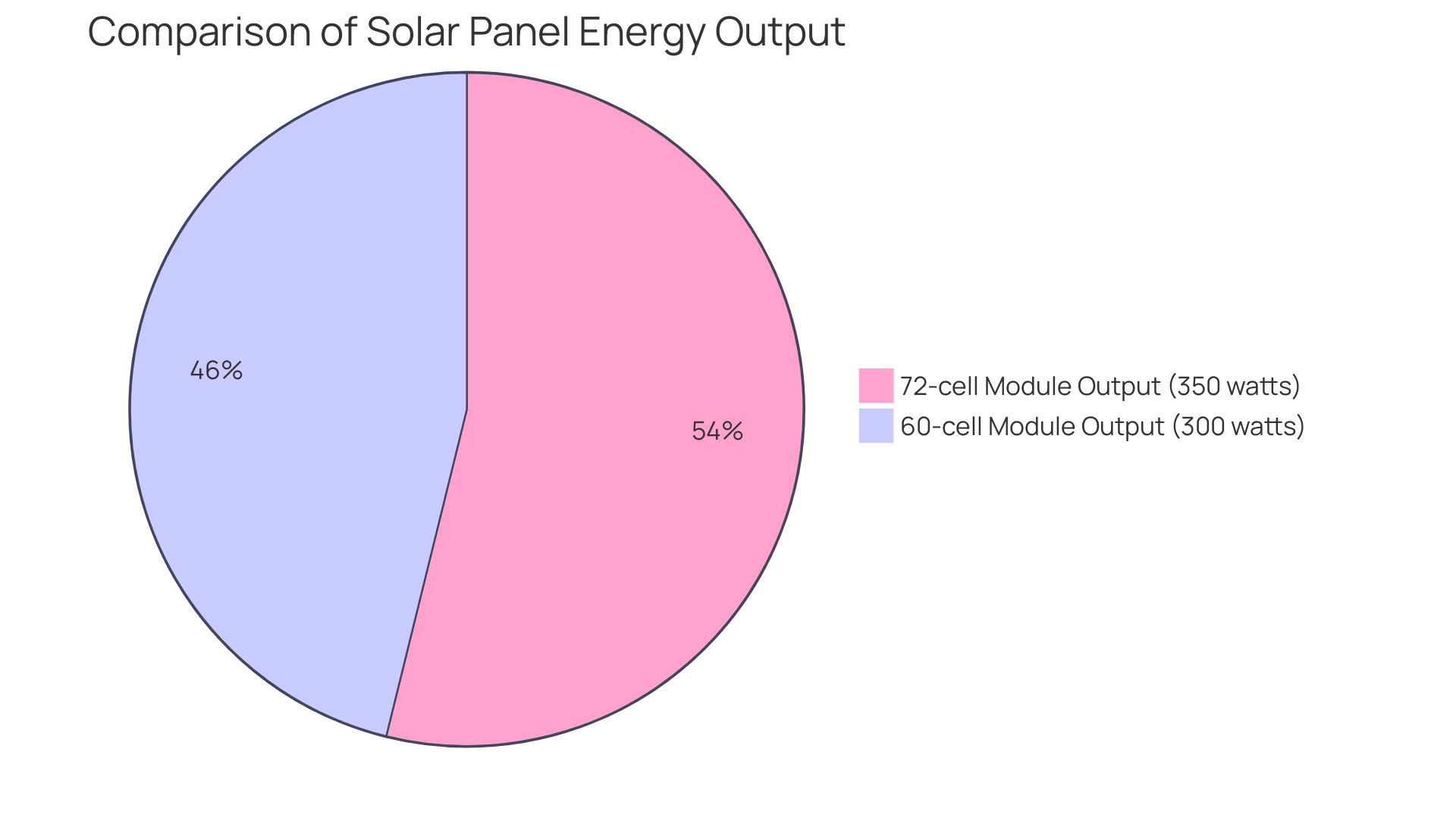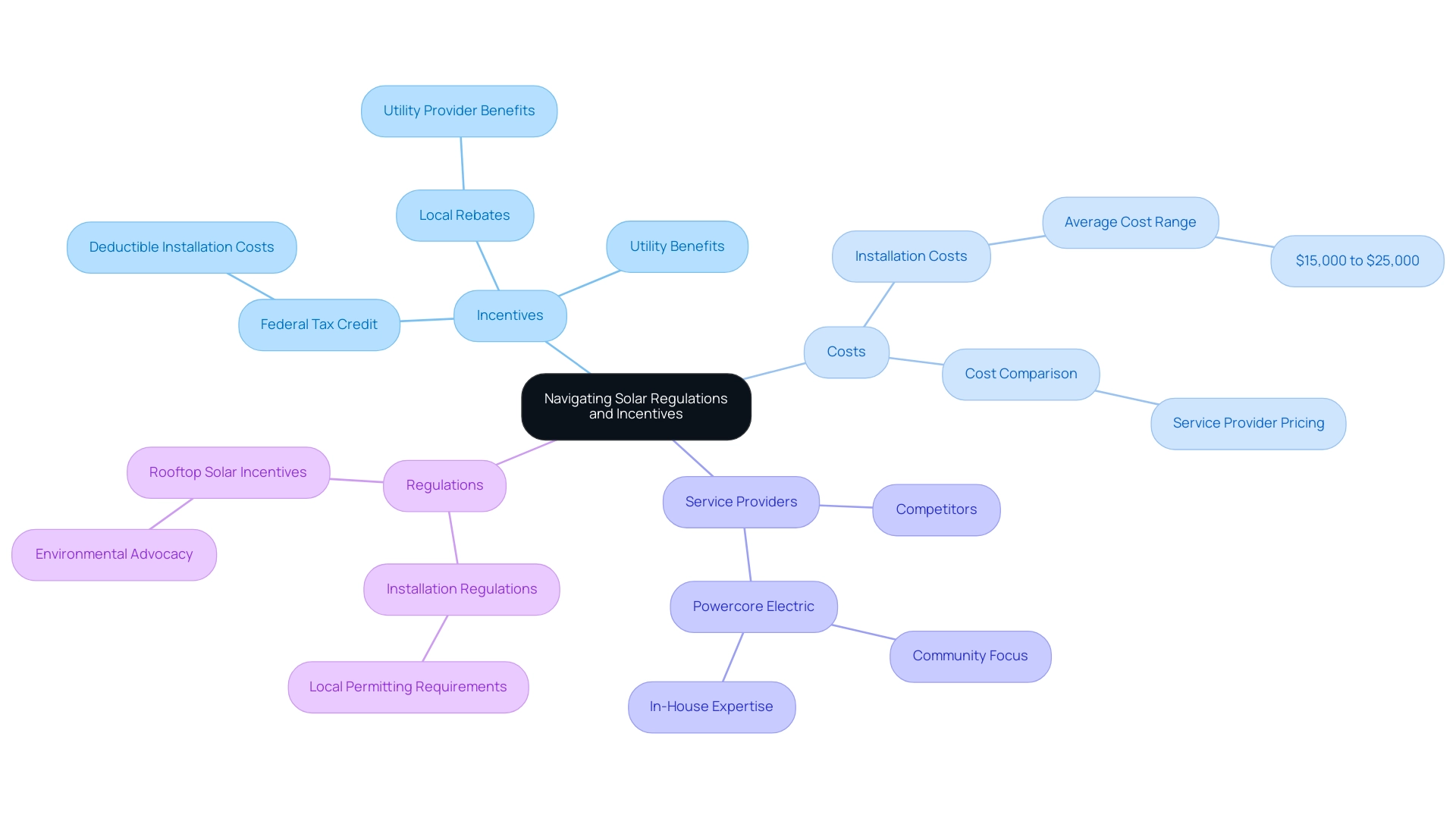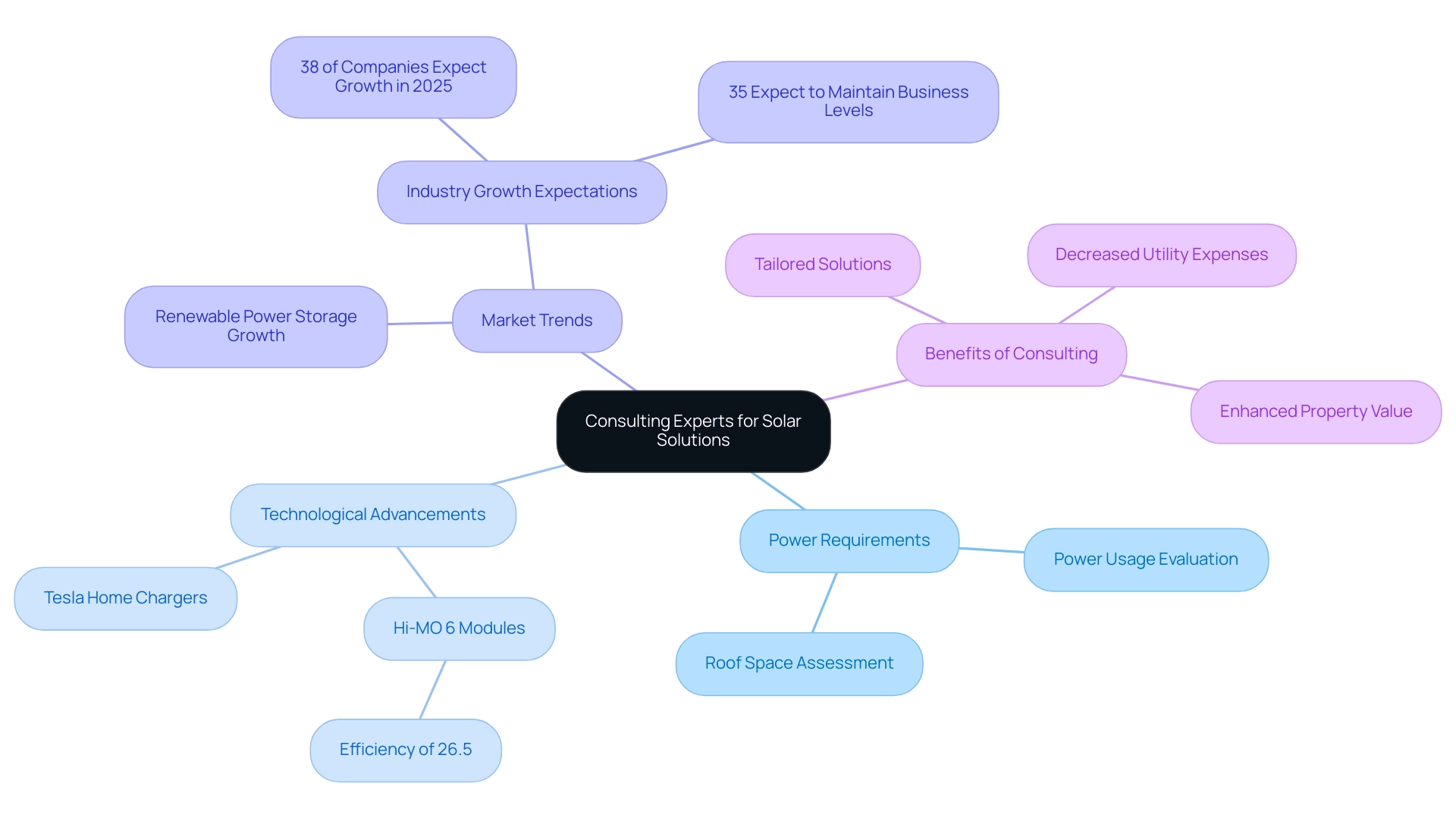Overview
We understand that managing energy bills can be a significant concern for homeowners. To determine how big a solar panel you need, it’s essential to consider your power consumption, available roof space, and the efficiency of the panels. Larger units generally produce more energy, which can lead to substantial savings.
By understanding these factors, along with consulting experts, you can make informed decisions that maximize energy production and reduce utility costs. Together, we can explore sustainable solutions that not only benefit your wallet but also contribute to a cleaner environment.
Let’s work towards achieving energy independence and a brighter future for your home.
Introduction
In the quest for sustainable energy solutions, we understand that many homeowners are concerned about rising energy costs. This concern makes understanding solar panel sizes a pivotal first step in harnessing the power of the sun.
With a variety of panel dimensions available, from the commonly used 60-cell panels to the larger 72-cell options, the choice you make can significantly influence energy output and overall efficiency.
As energy costs continue to rise, the urgency to optimize solar installations has never been greater. This article delves into the critical factors that affect solar panel sizing, the implications for energy consumption, and the potential benefits of making informed decisions in the rapidly evolving solar market.
By exploring these elements, we can navigate the path towards energy independence and sustainability together, ensuring your solar investments yield maximum returns.
Let’s work towards a brighter, more sustainable future.
Understanding Solar Panel Sizes: What You Need to Know
We understand that rising energy bills can be a significant concern for homeowners. Solar modules, available in various sizes, can provide a solution. The most common options are 60-cell units, measuring approximately 65 inches by 39 inches, and larger 72-cell units. The dimensions of these panels directly impact their wattage output, which is crucial for determining how big a solar panel you need to meet your power requirements. For instance, a standard 60-cell module typically produces between 250 to 400 watts, while a 72-cell unit can generate even higher outputs, often exceeding 400 watts.
As you consider how big a solar panel you need, it’s essential to think about your power usage and the available roof area. With advancements in photovoltaic technology, the market is leaning towards larger modules to meet increasing power demands. By 2025, we anticipate the average wattage output of photovoltaic panels will rise, reflecting improvements in efficiency and design.
Recent statistics reveal that national electricity expenses have surged by about 32% over the last decade. This trend underscores the importance of investing in alternative power solutions. Not only do photovoltaic installations offer financial benefits, such as reduced utility expenses and greater energy independence, but they also play a vital role in promoting sustainability by lowering greenhouse gas emissions and mitigating climate change. As Ben Zientara, a policy analyst in renewable energy, observed, “Despite the hardships of 2024, installers remain hopeful that 2025 will be an improvement.”
Consider the practical implications of photovoltaic system dimensions on your energy costs. A homeowner who opts for larger 72-cell modules may experience a significant decrease in utility expenses compared to those using smaller modules, as the higher wattage output allows for greater power generation. Furthermore, the Market Insight Report indicates that the global photovoltaic sector was valued at approximately £67.8 billion in 2022 and is projected to grow to about £161.9 billion by 2030, driven by technological innovations and heightened environmental awareness.
In conclusion, understanding the dimensions of photovoltaic systems and their associated wattage outputs is vital for residents looking to determine how big a solar panel you need. By reflecting on these factors, you can effectively harness clean energy resources, reduce costs, and contribute to a more sustainable future. Together, we can work towards a greener world while ensuring equitable access to renewable sources.
Key Factors Influencing Solar Panel Size
Determining how big a solar panel you need for your home involves several critical factors, especially for eco-conscious homeowners in Long Beach who are eager to embrace solar power solutions. We understand that navigating energy costs can be overwhelming, so start by calculating your average monthly power consumption in kilowatt-hours (kWh), which can be easily derived from your utility bills. In California, the average monthly power consumption for residential homes in 2025 is projected to be around 550 kWh, reflecting the state’s unique power demands and climate conditions.
Next, evaluate the available roof space for solar energy installation. Homes with larger roofs can support more units, which is essential for maximizing energy production. The orientation and angle of your roof also play a significant role; south-facing roofs typically receive the most sunlight, enhancing efficiency.
It’s common to feel uncertain about local climate conditions. Factors such as shading from nearby trees or structures can significantly affect the amount of sunlight your units receive, thereby influencing the ideal size and arrangement of your energy system. For instance, homes in areas with frequent cloud cover may require larger systems to compensate for reduced sunlight.
Expert insights suggest that homeowners should also consider the efficiency ratings of the solar systems they choose. Higher efficiency panels can generate more power in a smaller space, which is particularly advantageous for homes with limited roof area.
Additionally, it’s important to acknowledge California’s dedication to sustainable resources, as demonstrated by the U.S. Department of Energy’s investment of over $21 million in approximately 40 tribal renewable initiatives since 2010. This investment highlights the state’s commitment to sustainable power options, making renewable installations a timely consideration for property owners.
As Hannah Bastawrose noted, “As the cost of living continues to increase year over year, everyone is naturally on the hunt for more ways to save.” This sentiment resonates with many eco-conscious homeowners looking to lower their costs through solar power solutions.
Furthermore, case studies reveal that power prices and their influencing factors vary across regions. For instance, Hawaii and Connecticut encounter high utility bills due to geographical isolation and transit costs, despite lower power consumption. This emphasizes the significance of customizing sun energy array dimensions to personal situations, ensuring that homeowners can efficiently lower their utility expenses and improve power independence.
In summary, when selecting modules, it’s important to determine how big a solar panel you need by taking into account your power usage, roof area, orientation, local climate, and module efficiency. By carefully analyzing these factors, and with the expertise of Powercore Electric’s in-house team of specialists, we can work together towards making informed decisions that lead to a successful installation, maximizing both economic and environmental benefits.
How Solar Panel Size Affects Energy Output
As homeowners, we often find ourselves concerned about rising energy bills and the impact they have on our budgets. The dimensions of a solar module significantly influence its power output, and understanding this can help alleviate those worries. Generally, larger units, such as those with 72 cells, are designed to capture more sunlight compared to their smaller 60-cell counterparts. This expanded surface area enables improved electricity production, making larger modules a more efficient option for homeowners with greater power requirements.
Imagine a scenario where a 72-cell module can generate considerably more power than a 60-cell module when both are set up under the same circumstances. This is especially advantageous for homes that use more electricity, offering a potential solution to your energy concerns.
In 2025, the output discrepancies between these two types of modules have become increasingly significant. Studies indicate that while a typical 60-cell module may yield around 300 watts, a 72-cell unit can produce upwards of 350 watts or more, depending on the specific model and environmental factors. This distinction can be crucial for homeowners seeking to optimize their investment in renewable power and reduce their energy costs.
Moreover, the effectiveness of the cells within the panels also affects overall electricity generation. Current photovoltaic technology typically achieves efficiency ratings between 15% and 20%, as noted by Consumer Affairs. Advancements in sunlight technology, such as hybrid systems that incorporate molecular thermal storage, are pushing these boundaries further. For instance, a recent case study demonstrated a hybrid device that improved the efficiency of photovoltaic cells by cooling them, thus enhancing their performance. This hybrid system accomplished a sunlight utilization efficiency of 14.9%, demonstrating the potential for improved performance in future renewable systems.
Real-world examples illustrate the effect of module size on power production. Homeowners who have chosen larger modules often report a significant reduction in their utility costs, as these systems can produce enough power to satisfy or surpass their consumption requirements. It’s common to feel hesitant about the weight of photovoltaic systems; for example, 16 systems covering 288 square feet would weigh around 1,296 pounds, requiring adequate structural support during setup.
As the demand for renewable power solutions increases, understanding how big solar panels you need in relation to system size and output becomes crucial for making informed choices about solar investments. Together, we can explore the best practices for selecting energy inverters and the economic and environmental advantages of heating systems, including both active and passive solutions. Although photovoltaic systems are an important choice for enhancing power efficiency, residents may also explore alternatives like transitioning to a sustainable power plan that compensates for consumption with renewable resources.
Furthermore, Powercore Electric provides a variety of battery options that can improve energy storage efficiency, further maximizing the advantages of photovoltaic installations. Let’s work towards a more sustainable future together, ensuring that your energy needs are met with compassion and understanding.
Space Requirements for Solar Panel Installation
When preparing for the installation of photovoltaic systems, especially for environmentally conscious homeowners in Long Beach, it’s important to consider how big solar panel do I need in relation to the available roof area. On average, each photovoltaic module requires about 18 square feet of space. For instance, if you’re asking how big solar panel do I need for a system with 20 units, you’ll need approximately 360 square feet of usable roof space.
With 500 square feet of open roof area, residents can determine how big solar panel do I need to accommodate around 25 photovoltaic modules, thereby optimizing their energy generation capacity.
We understand that space is just one aspect; thoughtful evaluation of the module arrangement is equally crucial. Panels should be spaced adequately to prevent shading and ensure maintenance access. Current best practices recommend maintaining a minimum gap between panels to optimize sunlight exposure and enhance overall efficiency.
Additionally, it’s vital for property owners to familiarize themselves with local building codes and regulations regarding roof load capacity, ensuring that their structure can support the additional weight of the panels.
As the renewable energy sector continues to expand, with over 30 GW installed in the U.S. as of Q3 2024, grasping these requirements becomes increasingly important. The Inflation Reduction Act has significantly boosted renewable energy deployment, projecting a 46% increase in installations over the next five years. This growth highlights the necessity for property owners to strategize effectively for their renewable systems, ensuring they can capture clean power efficiently and sustainably.
Furthermore, according to Jacob Marsh, a system generating 16.8 kW equates to approximately 21,840 kWh of output annually, showcasing the substantial energy advantages of installing photovoltaic systems.
In addition, exploring alternatives such as Tesla home chargers and efficient energy storage batteries can enhance energy retention and utilization. It’s also essential to consider the environmental challenges posed by PV technology, including biodiversity impacts and resource consumption. Moreover, advancements in photovoltaic technology, like the record efficiency of solar cells held by Fraunhofer ISE at 47.6%, may influence property owners’ decisions regarding panel installation.
Routine upkeep and innovative cleaning methods are vital for ensuring the durability and effectiveness of energy systems, making it essential for property owners to stay informed about best practices. Together, we can navigate these considerations and work towards a sustainable energy future.
Navigating Regulations and Incentives for Solar Installations
Before embarking on a renewable energy system setup, we understand that property owners may feel overwhelmed by the local regulations and incentives that can significantly impact their investment. In California, a variety of state and federal incentives are available to encourage the use of renewable energy. Notably, the federal tax credit for 2025 allows property owners to deduct a substantial percentage of their installation costs from their federal taxes, providing a meaningful financial benefit.
Imagine the relief of saving thousands of dollars—this makes renewable power not only attainable but also appealing.
In addition to federal incentives, local utility providers in California often offer rebates and additional benefits for photovoltaic installations. This further enhances the financial feasibility of transitioning to renewable sources. Many property owners have successfully taken advantage of these tax credits and rebates, leading to reduced upfront costs and quicker returns on their investments. The potential of solar energy in California is impressive; for instance, Aquamarine in Lemoore boasts a capacity of 325 MW, enough to power over 90,114 homes, showcasing the vast renewable power potential in the state.
For homeowners, understanding how big a solar panel you need is essential when considering the expenses associated with photovoltaic systems. A thorough assessment of your solar panel needs and their efficiency can guide you in making informed choices that align with both your budget and energy requirements. For example, the average cost of a residential photovoltaic panel installation in California ranges from $15,000 to $25,000, depending on the size and type of system selected.
Additionally, evaluating different service providers is crucial to ensure you receive the best value for your investment. By comparing options from various firms, such as Powercore Electric and its competitors, you can uncover significant differences in pricing, service quality, and available incentives, ultimately influencing the overall cost-effectiveness of your energy solutions.
It’s also important to stay informed about California’s installation regulations for renewable energy, which can vary by locality. We encourage homeowners to consult with local authorities to understand permitting requirements and any specific regulations that may apply to their area. This diligence not only ensures compliance but also maximizes potential savings and benefits from available incentives.
As Dan Hopper, Managing Director of Regulatory Policy at Edison, insightfully pointed out, “It’s an inaccurate statement, from my perspective, to say it’s about utility profits,” highlighting the complexities surrounding energy incentives.
As the landscape of renewable power continues to evolve, environmental organizations are actively advocating for the preservation of rooftop incentives, emphasizing the importance of photovoltaic panels in reducing greenhouse gas emissions. By staying informed and utilizing available resources, homeowners can make choices that contribute to a sustainable future while enjoying the financial benefits of renewable power. Powercore Electric distinguishes itself with its strong community focus and commitment to transparency, ensuring that clients receive personalized service and support, establishing it as a trusted partner for energy installations.
Consulting Experts: Tailoring Solar Solutions to Your Needs
Consulting with a photovoltaic installation specialist from Powercore Electric is essential for tailoring your system to meet your specific power requirements. We understand that navigating energy bills can be daunting, and these professionals perform thorough evaluations of your power usage, available roof space, and local regulations. This allows them to determine how big a solar panel you need and suggest the optimal configuration customized to your circumstances. Recent advancements in photovoltaic technology, such as the Hi-MO 6 modules with an impressive efficiency of up to 26.5%, underscore the importance of staying informed about the latest products that can maximize your power output.
Furthermore, innovations like Tesla home chargers and effective battery storage solutions are transforming how residents can utilize renewable power efficiently. Collaborating with specialists not only simplifies the installation process but also greatly enhances the likelihood of reaching your power objectives. A professional evaluation can uncover insights into your power consumption trends, helping you understand how big a solar panel you need for your renewable investment. Statistics suggest that a significant segment of property owners are focusing on self-sufficiency, with the domestic renewable power storage market expected to grow as more individuals aim to enhance their renewable resource use.
This trend aligns with insights from industry experts, who note that 38% of all companies in the sector expect to grow in 2025, emphasizing the relevance of consulting experts in a thriving market. Moreover, expert recommendations have led to numerous successful installations, showcasing the tangible benefits of tailored solutions. For example, case studies from Powercore Electric illustrate how property owners have notably decreased their utility expenses and enhanced their property value through tailored renewable solutions. By utilizing the expertise and experience of renewable professionals, together we can ensure that your system is not only efficient but also aligned with your long-term power objectives.
As we look towards 2025, the solar industry will continue to evolve, and the importance of consulting with installation experts will only grow. It’s an essential step for any eco-conscious homeowner looking to transition to solar energy. Let’s work towards a sustainable future together.
Conclusion
Understanding the intricacies of solar panel sizes can feel overwhelming, especially for homeowners concerned about optimizing energy consumption and reducing costs. It’s common to wonder about the differences between 60-cell and 72-cell panels; the choice can significantly impact energy output. Larger panels generally offer higher wattage and efficiency, which can translate into greater savings. By thoughtfully assessing your energy needs, available roof space, and local climate conditions, you can make informed decisions that truly maximize your solar investments.
As the solar market evolves, so do the opportunities for financial incentives, making solar energy more accessible than ever. With the potential for substantial savings through federal and local rebates, homeowners can capitalize on these financial benefits while contributing to a sustainable future. We understand that navigating these options can be challenging, and consulting with experts can further streamline the process, ensuring that your installations are tailored to your individual requirements and aligned with the latest technological advancements.
Ultimately, embracing solar energy not only leads to reduced utility bills and increased energy independence but also plays a vital role in mitigating climate change. By recognizing the importance of solar panel sizing and leveraging available resources, you can take significant steps toward a brighter, more sustainable future. Remember, the journey toward renewable energy is not just a personal investment; together, we can create a collective movement towards a healthier planet for generations to come.


